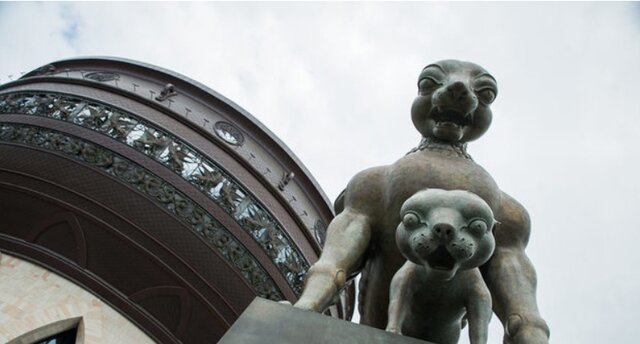In the photo is a fragment of the art of the Buddhist sculptor Dashi Namdakov. Against the backdrop of the Pope’s controversial statements, which did not receive enough attention from Russian-speaking Muslims, another religious leader made statements.
During his visit to Kazan, one of the leaders of Russian Buddhists, Lama Badmaev, said the following: “In order for us to talk about unity, we need to engage in some enlightenment. And I suggested that we at least organize Buddhist rooms in Kazan or build a Buddhist temple, a datsan – if there are Buddhists here.
According to media reports, the first president of Tatarstan and current adviser to its nominal head, Mintimer Shaimiev, replied that such wishes “deserve attention. We have repeatedly written that if Russia adhered to its written constitution, all religious organizations would be free to open and build their centers and temples throughout the country.
For example, Muslims in Moscow and other large cities where there is a shortage of mosques. And similarly, Buddhists in Kazan, if they really need a temple there. But here is the problem. It is well known how things are going with the construction of new mosques in Moscow. By the way, in the capital of a state where tens of millions of Muslims live, including representatives of peoples who (unfortunately for themselves) ended up there with their lands.
The situation is the same in other cities, usually with the exception of Muslim republics, and even then not always and not for everyone. One could say that this is an illustration of the attitude towards Muslims from the “Orthodox Russian world”, whose leaders only start talking about Allah, Jihad and Iblis when they smell something frying and Muslims are needed as cannon fodder.
But even against this background, the oppression of girls in hijabs and the opening of new mosques in Moscow continue here and there. The problem, however, is that the Buddhists often do not differ from the Orthodox in such attitudes.
For example, in Elista, the capital of Kalmykia, one of the main Buddhist republics, where about 40,000 Muslims live, the only Islamic cultural center, not even a mosque, was built from 1997 to 2002. When it opened, it could hold only 50 worshippers. But it was burned down in 2014, leaving Elista’s 40,000 Muslims without a place of worship. The mosque, located 120 kilometers from Elista, was demolished in the early 2000s.
One might wonder if there are more than 40,000 Buddhists in Kazan. It is doubtful. However, if you search for “Kazan Buddhist Center,” you will see that there is such a center. And by the way, if we mention Mintimer Shaimiev, he has already been noted for his special attitude to Buddhism, which takes quite strange forms.
For example, in the complex built with his help in Bulgaria, which was conceived as an Islamic center for the Tatar people, an 11-meter statue of a dragon creature was erected, the sculptor of which was the Buddhist Dashi Namdakov. He seemed to be an educated person… to know that in Islam, especially in such places, such sculptures are not welcome. And in general, how correct is it for a representative of one confession to interfere in the construction of a complex planned as a center for another confession?
In this connection it is impossible not to mention another point. Since the Putin regime, with its suicidal policy, has deprived Russia as a state, at least in its present form and borders, of any prospects, representatives of the peoples who still belong to it have already begun to think actively about how to live after its collapse. Buddhist Kalmyks are actively doing this, which is reasonable from their side.
If it weren’t for one thing – while declaring their plans to create an independent Kalmykia, the leaders of their national movement announced their intention to include Nogai lands in Astrakhan, which has already caused protests from the Nogai movement.
In this regard, it would be desirable to avoid misunderstandings. Northern Eurasia is, of course, not Afghanistan or Burma, but a space where Islamic and Buddhist religions and their followers will have to coexist in one way or another. And so far, the situation in Kazan is better than in Elista, where, despite the smaller number of followers, no one burns the temples of the other community.
Therefore, it would be logical for Lama Badmaev, if he wants to further improve the position of Buddhists in Kazan, to start by helping to build a mosque in Elista – of the size he would like to see for the Buddhist temple in Kazan. And to the respected representatives of the Kalmyk national movement, it is worth explaining that the Nogais are not a neglected people, as it may seem.
They are part of the Islamic ummah, which can always count on the support of their co-religionists from the Caucasus, Idel-Ural and Turkestan in case of encroachment on their rights and lands. And anyone who has plans for the lands they inhabit should remember this.

